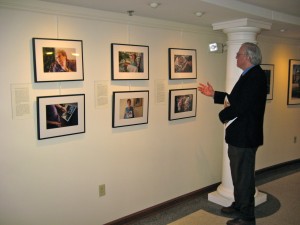#320 – Dick Bernard: Las Madres: Mothers of the Disappeared
Sunday we were privileged to attend a photo exhibition and talks telling the story of the Las Madres, Argentine Mothers who lost children during Argentina’s “dirty war” 1976-83.
The event was presented by the Twin Cities organization World Without Genocide, a group worth learning more about.
At the Sunday gathering, the photographer Sylvia Horwitz gave a powerful commentary on her equally powerful photographs. Her story began, ironically, with a 2003 trip to Argentina to learn the Tango.
During that trip she learned of Las Madres, and later returned to document the continuing demonstrations to keep alive the memories of horrendous atrocities against basic human rights during the dictatorship of 1976-83 in Argentina. The photo exhibit continues at the Basilica undercroft through March 5. It is very well worth the visit.
Also speaking at the Sunday gathering was a twin cities teacher who survived the awful detention and torture. Her journey to near-annihilation began very innocently, as an idealistic young person leaving fliers on a bus bench. She was noticed by the wrong person, detained and tortured, and in the end was very lucky to survive. Most of the detained weren’t: they simply disappeared.
Among the materials I picked up was a commentary from the Nov. 27, 2010, issue of The Economist on the architect of this “dirty war”, Emilio Massera, who died November 8, 2010, at the age of 85. The description of Massera’s self-delusion – “cleansing the country”, as described in the commentary – is chilling; as is his fascination with the manipulation of language to wield power.
Like tyrants of any age, Massera felt he could learn from the mistakes of tyrants who came before.
In Nazi Germany, for instance, detailed records were kept of everything.
In Massera’s Argentina, there were no records, and thus it is virtually impossible to reconstruct the atrocities, determine what happened to the victims, or establish evidence to convict the perpetrators.
The memory of the atrocities lives quietly on, even in minds of persons who have no particular background or interest in Argentina.
Saturday morning, a friend of mine leaves for Buenos Aires in the first leg of a cruise around the Horn of South America. In conversation, he and some friends were wondering about how safe it was to go to Argentina.
That is the legacy of 1976-83 living on.
At the end of the program, a friend of mine, a retired attorney, reflected on what we had just heard and seen. What happened in Argentina in those lost years, he said, could as easily happen here, and has happened elsewhere.
One needs to be vigilant.


